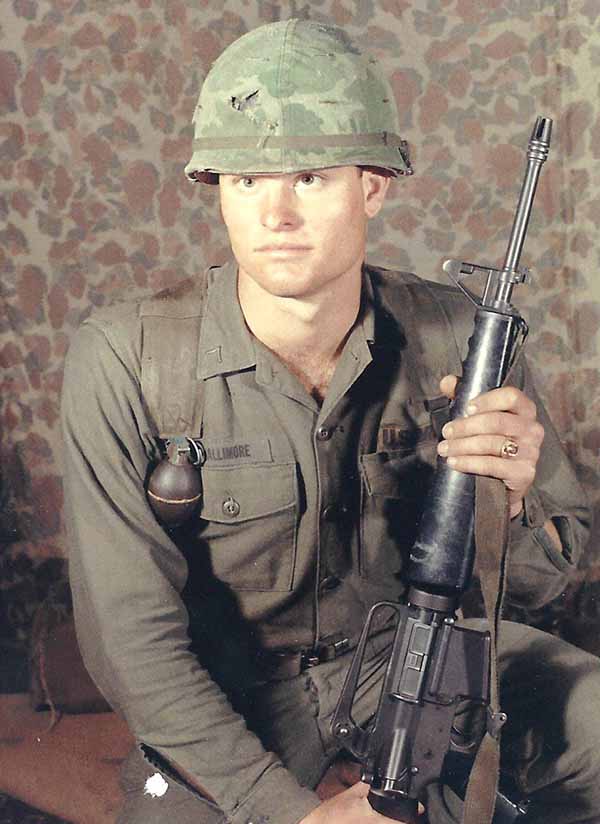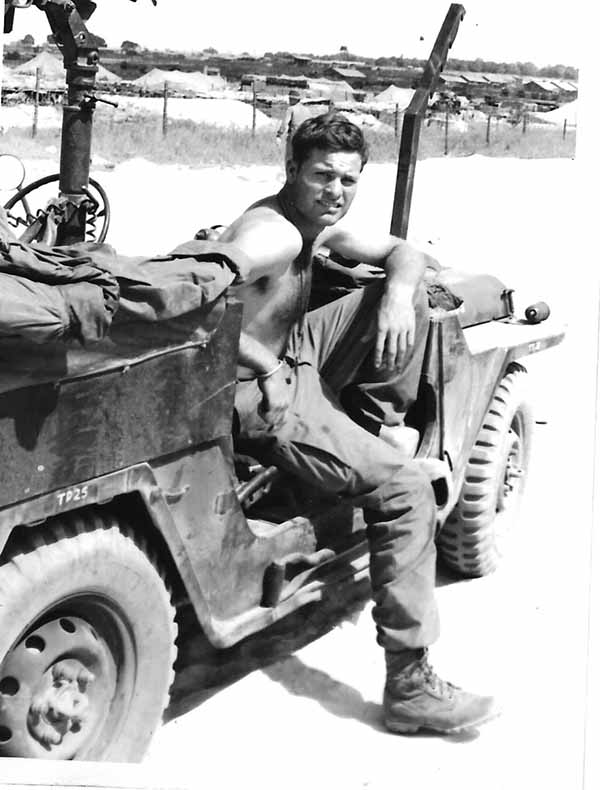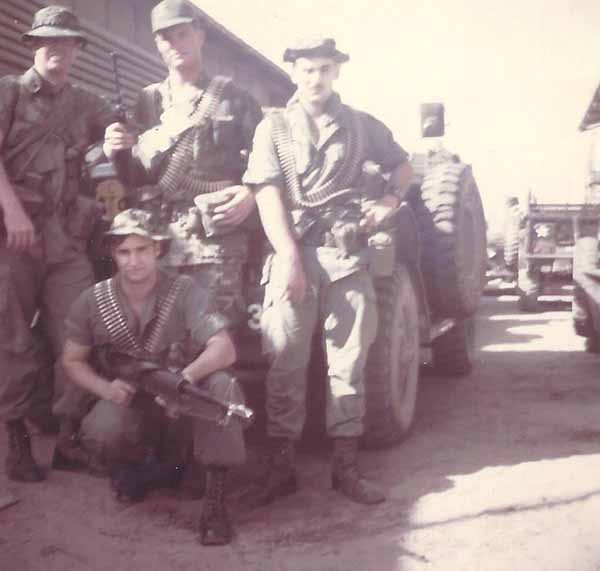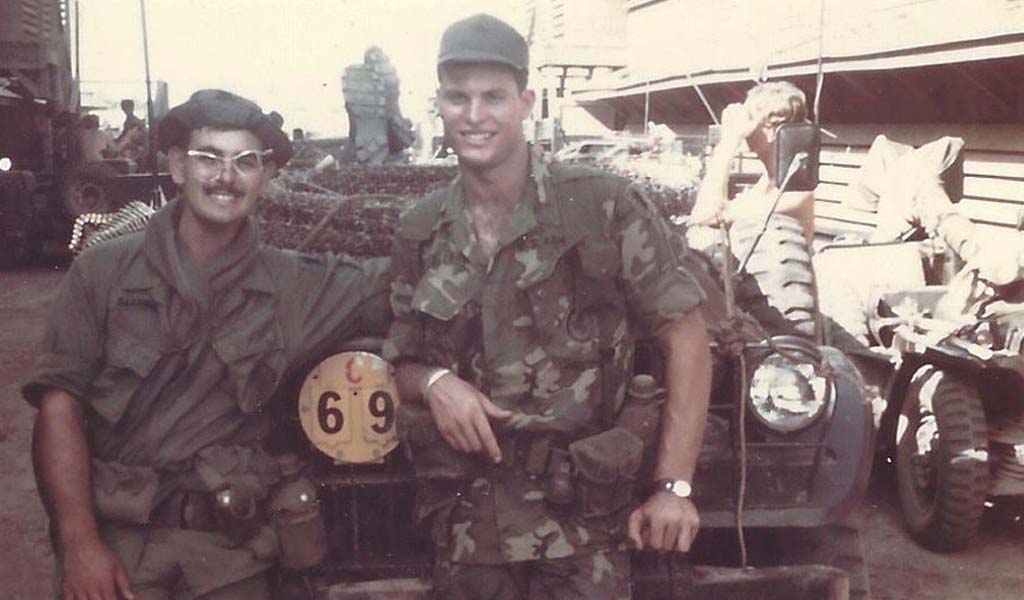Picture above: A buddy wearing goofy glasses with Sgt. Hallimore
Blackhawk Unit- 7th Armored Squadron (Air)
First Cavalry – Attached to the 1st Aviation Brigade
VINH LONG, VIETNAM

As a teenager I often had a reoccurring dream which I hoped would never end; in the dream, I was able to fly. I can still feel the wonder of soaring like a bird; these were daylight flights, a couple hundred feet above the outdoor mountain landscape. In my dreams, I simply concentrate on my body lifting off. I would begin to levitate through the power of concentration and easily ascend up and away.
I would float in a vertical, standup position, and soon would be sailing along; with the ability to control my direction and speed of travel through a strong and continuous mental focus. These solo flights were accompanied by deep blue skies and always happening over beautiful tree topped forest and lush grassy meadows.
I soaked up the amazing views, looking down at the treetops in a sense of freedom that I imagine only eagles feel. The irony of having these dreams, with such clear perspective of the treetops and landscape below seems surreal since I had not yet flown in any type of aircraft.
In the Army
My lack of actual air travel quickly changed when I joined the Army. There were commercial airline and military aircraft trips to various Army training stations with particularly memorable trips to and from Vietnam; the airliner which held row after row of soldier appeared to be larger than any imaginable winged object should be. How could such a big bus even get off the ground?
But by far, the most captivating flight was that in helicopters. During my Vietnam tour, it is the many hours flying in helicopters that recreated that childhood perspective of beautiful treetop flying (which I no longer experienced in my dreams).
Wop-wop-wop-wop
It is the loud, yet distinctive ‘wop-wop- wop- wop’ chopping of the air as the Huey’s large main rotor lifts and pulls its flight cargo forward.
Even today, the unique sound will pull my eyes to the heavens in search of that familiar big bird. There are indelible memories of those UH-1 birds with a model name ‘Iriquois’ These were the predecessor of the ‘Blackhawk’ model helicopter and were the backbone of the Vietnam war and troop movement.

Pvt. Hallimore during early training in the States prior to Vietnam

Sgt. Hallimore on convoy duty excorting trucks carrying fuel throughout the Delta

Hallimore with buddies
Slicks, Big Birds, and Hueys
When flying in these “slicks” a favorite position would be two or three of us sitting on the outside edge of the compartment with our legs and jungle booted feet dangling out over the skids (there were no seats, 8 or so soldiers would be sitting on the Huey’s floor). The large sliding doors would be pinned open on either side so that you could easily see right through the mid portion of the bird.
A door gunner with an M-60 machine gun sat on a seat in a notched area on either side of the helicopter attached to and slightly to the back of the cargo/troop carrying area. Centrifugal force would hold us in as the helicopters made sharp banking turns during flight. During those gravity defying swoons, a soldier would be looking straight down (maybe 1500 feet to the ground) without slipping out.
Flying treetop, they seemed to be half crazy
The young warrant officers who flew helicopters in Vietnam probably became some of the best pilots ever, but they seemed to be half crazy as they pushed those birds to their maximum performance. They would come in fast and stand the bird on its tail to stop quickly. They could hover partially in or over water while troops got in or jumped out. They would fly treetop at full speed hitting the tips of the trees with the choppers skids. A few feet higher would have seemed prudent.
Flying treetop minimized exposure time to possible ground fire. As a full platoon vs. smaller squad movement, we occasionally flew in the twin rotor Chinook Helicopters (we called them ‘shit-hooks’). They were much larger than the Huey UH-1 and could carry a significant pay load. They were also quite fast. At times, we would be flying at full speed in a Chinook Helicopter just 6 or 7 feet off the water of the Mekong River; it seemed ill advised with little room left for pilot err. I would be thinking that flying a little (or a lot) higher would make good sense. But since I was ground pounder (combat foot soldier), I didn’t waste time expressing my opinion.
The helicopters were so important.
I would watch the small ‘Loachs’ (Light Observation Helicopters) fly at treetop level with a pilot and a single adjacent seat door gunner as the decoy. They scouted the jungles trying to draw fire as a method of locating the enemy; this was a job for someone who had a death wish in my opinion.
More dangerous than the actual combat field?
The Cobra helicopters possessed an awesome array of armament and firepower that was very welcomed when we needed their assistance during a firefight. There were also very large skeleton like helicopters called ‘Flying Cranes’ hollowed out underneath with a sling and the ability to hook and pick up extremely heavy loads of equipment. I had a lot of appreciation for the utilization of wartime helicopters, but I often wondered if the wild ‘amusement park’ rides performing troop deployment in those magical machines we called ‘slicks’, ‘big birds’ and ‘Hueys’ weren’t more dangerous than the actual combat field mission itself.
It was generally said that a soldier was most likely to get killed in his first 30 days or his last 30 days in Country.
The early loss due to mistakes caused by a lack of experience and the late loss due to anticipation of leaving and the development of careless habits. In my unit, when there were 30 or less days left in a combat soldier’s tour, he would typically not be required to participate in field operations. When I had 17 days left in Country, I volunteered to participate in a joint American ARVN (Army of the Republic of Vietnam) mission. These joint missions had become common place during the ‘Vietnamation of the War’. After 11 months of active operations, the idleness of staying within the perimeter of our Army base/compound became monotonous, I needed something to do. This last voluntary trip to the field became the most memorable air mobile mission of my life.
Our ground unit was stationed in Vinh Long with combat operations throughout the delta.
Most of the delta is covered in water. It must have been the wet season because the water in the rice paddies came close to being waist deep. There were only a few of us Americans working as advisors to the ARVNs on this particular mission. In our trusty UH-1 helicopters, we flew in and jumped into about 3 feet of murky water covering the rice. We were at the assigned LZ (landing zone). I don’t remember much concerning the mission. The day spent with the ARVNs was uneventful. Generally not much did happen when we jointly deployed with the ARVNs. It was a long term war for them and they had a knack of regularly avoiding enemy contact. Many of the ARVNs had spent their full adulthood as soldiers. Their Country had been in a no-win war for over a decade. Surviving became a greater motivation than mixing it up with the Viet Cong. The American mindset was different. We wanted to fight, we wanted to win and we wanted to return to our good life ‘Back in the World’.
At the end of the day, we called in the birds (Hueys) for extraction of the troops.
We would have stood in the water probably near the tree-lined edge of the paddies waiting for the helicopters to arrive. When we heard them coming, we would ‘pop smoke’ in the opening so they knew where we were. The Helicopters would fly in and hover with their skids just touching or slightly in the water. That afternoon, the water in the LZ was somewhat deeper than usual. The helicopter may have hovered or sat a little lower in the water for us to get in. Each helicopter would pick up about 8 to 10 soldiers. Since we were a joint force, the Vietnamese were lighter weight and more could be carried. As we climbed up on the skid and into our chopper, I took my normal position sitting on the edge of the deck with my feet hanging out over the helicopter’s skid. It was time to head back to our Army base.
Flying a helicopter is a skill that I don’t think is easily mastered.
But the American pilots who flew in Vietnam had a tremendous amount of practice; they were daring but so familiar with the maximum capabilities of their craft. As earlier stated, they pushed their birds to the limit. When taking off, there is an increased whine of the laboring turbine engine and a heavier ‘wop-wop-wop’ sound of the main rotor as it fights the air for dominance. Helicopters take off in a typical pattern of increasing the power and/or pitch of the rotor to lift the fully loaded bird up out of the water (or off the ground). The chopper then starts tilting forward, picking up momentum and speed. As the helicopter’s air speed increases, the chopper begins to climb.
As we took off, I was looking forward though the plastic canopy at the front of the Huey. There is a lower plastic canopy at the pilot and copilots foot pedal area that allows you to see down and out. I observed that the helicopter had started forward, picking up speed, but instead of going up, we were flying along partially touching the water.
“Another cool stunt by these crazy pilots”
At first the water was spraying out with just the skids contacting the water; I am thinking, ‘yes, here we are with another cool stunt of spraying water high in the air by these crazy pilots’. But, as I watched, instead of going up we were actually going down. Almost instantly, the slick became like an ocean liner plowing through a watery marsh swamp. I could feel the helicopter shutter and stumbling all very quickly as its nose dove even deeper……………
I was underwater, still holding my M-16
Within a split second, my next memory is that of being on my hands and knees under water with my M-16 rifle still held in both hands out in front of me on the ground. I could feel something relatively large and hard on my left and something similar on my right. My mind went into a hyper activity mode that I have never otherwise experienced. I thought I was trapped under the helicopter and knew I wouldn’t be able to hold my breath for long.
I thought I was going to die
In a very quick moment, I had a million thoughts go through my head. The turbo speed of my brain function was incredible. ‘Oh My God, why this?’ I thought of my family, my friends, my home and I thought how stupid it was to be out in the field with only 17 days left. I thought I was going to die and this was the only time that I ever felt that way.
I had to find a way out.
I had to find a way out. I started to move up off of my hands and knees. To my surprise, I was able to stand up. I was fine, I could breath. All of the troops on the helicopter were thrown out and the only two remaining in the helicopter were the pilot and the co-pilot. The helicopter had flipped over and came to rest upside down. The pilot and copilot were strapped into their flight seats upside down securely held in place by their seat belts. The flight helmets on their heads were just inches above that dirty water of the rice patty. The helicopter was destroyed but fortunately all of the personnel were OK.
The helicopter was destroyed but everyon was OK
Apparently as the helicopter started its angled path down in the water, the top rotor caught the ground and violently twisted and flipped the Huey UH-1 helicopter over. The force threw all of us out and away from the helicopter into the murky water of the rice paddy. One object at my side under water was the large top rotor and the other was one of the bulky doors that had been pinned back and open. It broke loose and flew off of its mount. I was thankful. We were lucky that day.
Well, I was happy to be alive and happy to return to base, but I was miffed. In my opinion, there were too many times that we had faced unnecessary risk while flying with the young Huey pilots. There was an investigation into the cause of crash and loss of the UH-1 Helicopter. It was a $250K piece of equipment in 1970. The interviewing officer for the investigation said that the pilots thought there was a cable stretched across the rice paddy that caught their skids and flipped us over.
What cable?
I told the officer how ridiculous such a story was. How would the Viet Cong know where to strap a steel cable in all of the rice fields throughout the Delta to cause a Helicopter accident? And of course when the Flying Crane picked up the helicopter to bring the damaged carcass back to base, was any cable found in the water?
It was my positon that pilot bravado and human err caused the destruction of the Helicopter which could have killed us all. Ultimately, the determination was made that when the Huey sat down in the water, hovering, the compartment below the floor deck filled partially with water. As the Helicopter tilted and started forward, the weight of the water in the under compartment moved forward driving the helicopter into the ground. I do not know if that was the truth or a cover up. It doesn’t matter.
It was a bad but memorable day……………yet it turned out alright! We survived another day without casualty. I was soon headed home. Our Blackhawk Unit continued with its air missions until leaving Vietnam in1972.
***NOTE: The above story, having a ‘good ending’, was one that I could share with my family soon after arriving home. When writing letters from Vietnam and after getting home I did not communicate the painful events experienced in war. I arrived home about 3 weeks after the ‘crash’. I still wonder about having that ‘hyper mind activity’ where my brain went into ‘turbo mode’.
My mother
My mother tells of being woken in the middle of the night, sitting up and hearing me yell her name. It is not like my mother to have such an experience. The time frames appear to mesh fairly well. Is there a higher level of cognitive function and method of distant communication available to human beings? ………………I don’t know. –


I don’t know how I ran across this story but at that time 1972 I would have been 12 at the end of the year. To young to serve in this war. But must say John Hallimore survival that day impact on my own life and others I know was a major part. When he returned he was a teacher in R.O.P. construction trades in 1977-1979 for 2 years. He gave me the tools and at least 3 others that I know of continued on to a long career in construction. At 64 I owe my career and the life I’ve had to what he was able to accomplish. I spent a little more time than normal with him as he recommended me for summer and after school time to work on construction projects for the school district, but never heard these stories or even about his service to our country. Many of us owe our lives here in the United States to him and other’s that fought for us and came back home to make a life changing impact on a then 17 yr old ,not much younger then than he must have been during his time in Vietnam. Thank You
My dad served in the Blackhawks August 1970- November 1971. Wonder if there is any chance you knew him. Troop C.